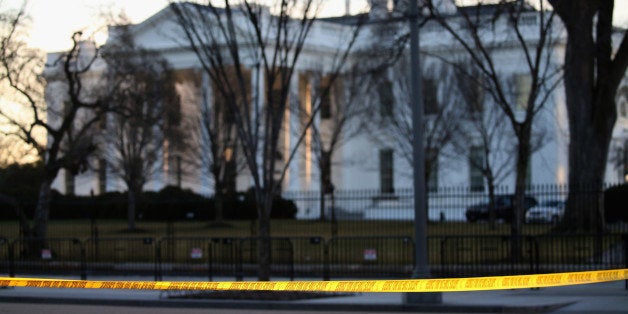
NEW YORK -- The latest United States Secret Service scandal erupted last week following reports that two high-ranking agents disrupted the scene of an investigation outside the White House, hit multiple barricades, and may have driven over a suspicious package, all while possibly intoxicated.
But surveillance video of the March 4 incident, according to a source who has seen it, suggests the agents' actions that night weren't nearly as erratic as originally described in news reports and, subsequently, by members of Congress relying on said news reports in TV appearances.
The source, who was not authorized to speak publicly about the video, told The Huffington Post that the footage shows two senior agents driving very slowly after arriving at the scene, perhaps just 1 to 2 mph. The source said the agents' car nudged a traffic barrel and that the action appeared to be intentional rather than reckless -- in an effort to move the object out of the way.
The source's reflections on the contents of the video echo reports from both CNN and Fox News. If proven true -- and the video could be made available to members of Congress in the coming days -- the evidence would raise questions about earlier reporting on the incident, the framing of which seemed to fit neatly into a long-running narrative of Secret Service agents out of control.
On March 11, The Washington Post's Carol Leonnig reported that Secret Service officials were being investigated for allegedly driving "a government car into White House security barricades after drinking at a late-night party last week." Leonnig wrote how "the vehicle ran through security tape before hitting the barricades," a description that suggests the pair was out of control. The report did not mention how fast the car was going.
The Post's original headline read: "Secret Service agents investigated for late-night car accident at White House" (which is still visible in the article's URL). According to NewsDiffs, the headline was later changed to "Secret Service agents investigated for driving car into White House barrier" and finally to "Secret Service agents investigated after car hits White House barricade."
Leonnig and Peter Hermann reported on March 12 that the agents were "suspected of driving under the influence" and "may have driven over the suspicious package."
The Post later tweaked the language of the story to report instead that the agents "drove directly beside" the package, instead of possibly over it.
Post national editor Cameron Barr said the Post updated the story after talking to officials who had "examined more video and concluded that, in fact, the car had driven immediately beside the package." The paper, he added, "routinely update[s] online stories as reporting develops, as do many other news organizations." He told HuffPost that the original headline was written by an editor and changed at Leonnig's request.
But by the time the updates were in the piece, however, it had already been tweeted by several Post editors and reporters, and retweeted widely. Several outlets published stories citing the Post's report that the agents may have driven over the package, even though the language was later changed.
The Washington Post led the charge, but several other news organizations supported the paper's initial report, also citing anonymous sources who described a chaotic scene involving the agents.
CNN reported soon after that "two senior Secret Service agents, including a top member of President Barack Obama's protective detail, crashed a car into a White House barricade following a late-night party."
The New York Times reported Wednesday night on allegations that agents had "crashed a government-issued car into a White House barricade after a night of drinking last week." The following night, a few hours after a subsequent Post report, the Times followed up with a story that seemed to confirm the dramatic incident: "Video Said to Show Secret Service Agents Driving Under Police Tape Before Crash." The headline was later changed to the more benign "Video Said to Show Secret Service Car's Low-Speed Blunder at White House."
But while several media outlets toned down the drama of the encounter outside the White House in later versions of articles or on-air segments, the initial reports -- suggesting possibly drunk agents crashing into barricades -- had already spread online, amplified on Twitter and cable news. The narrative had been set.
On Monday night, "Daily Show" host Jon Stewart knocked the news media for framing the incident as a wild, drunken car crash, a depiction that seems increasingly at odds with the emerging picture of the night in question.
Even before reports of the incident emerged, the Department of Homeland Security Inspector General had begun its investigation of the agents' conduct that night.
Questions remain as to why the senior agents, Mark Connolly and George Ogilvie, appeared to have taken a government car to a colleague's going-away party earlier in the evening, and why Director Joseph Clancy, appointed last month to lead the embattled agency, wasn't notified of the White House incident until five days after it occurred.
Clancy told members of Congress Tuesday that the footage showed the two agents nudging an orange construction barrel in order to pass, noting that the barrel in question didn't even fall over. He said the car proceeded to a checkpoint, and the agents appeared to show their badges in order to pass. Clancy also said that the agents' car was traveling at "a very slow rate of speed" into the White House complex. He added that the agents had returned to the White House at the time because one of them had left his car at the complex before attending the going-away party.
Rep. Jason Chaffetz (R-Utah), chairman of the House Oversight and Government Reform Committee, and ranking Democrat Elijah Cummings (D-Md.), had asked Clancy in a letter Thursday night for materials related to the incident, including the surveillance video.
A Chaffetz spokesperson didn't respond to a question Monday about whether the congressman had seen the video. A Democratic Oversight Committee staffer told HuffPost on Monday that Cummings had not seen the video, but hopes to do so on Tuesday.
"When you look at what happened here," Cummings told MSNBC's "The Rachel Maddow Show" on Thursday night, a few hours after the Post's report, "it is extremely alarming and shocking to the conscience that two senior supervisory types in the Secret Service could come and crash a barrier, basically tamper with a crime scene because they may have ran over the very thing that they thought was a bomb, and to put other people in danger because they appeared to have been impaired by alcohol."
That Cummings was apparently relying on Leonnig's reporting, and not his own review, to make these assertions isn't terribly surprising. The Post reporter has won wide praise for a series of scoops on Secret Service misconduct that led to the resignation of the agency's previous director, Julia Pierson.
But three other Secret Service stories of Leonnig's have also come under scrutiny in the past year, including erroneously reporting that a contractor riding in an elevator with the president was a convicted felon; relying on a questionable source for allegations of soliciting prostitution; and reporting that a Secret Service operation lasted at least two months when an Inspector General's report on the operation found "no evidence" it lasted more than a few days.
Leonnig won the prestigious Polk Award last month, primarily for two 2014 pieces that looked at the White House fence-jumping incident in September and at a 2011 shooting at the White House. That award could lead to an even higher honor, with the Pulitzer Prize set to be awarded next month.
"[S]he has and continues to be the authority on this story," said Barr, when asked about the evolving details of the latest Secret Service story. "We're very proud of her work."
This article has been updated with additional information from Clancy's testimony to Congress. Language has also been updated to reflect that an inspector general's report in October found "no evidence" to refute the Secret Service's claims that a 2011 operation lasted only a few days. The Post, citing three sources familiar with the operation, reported in May that it lasted at least two months.
